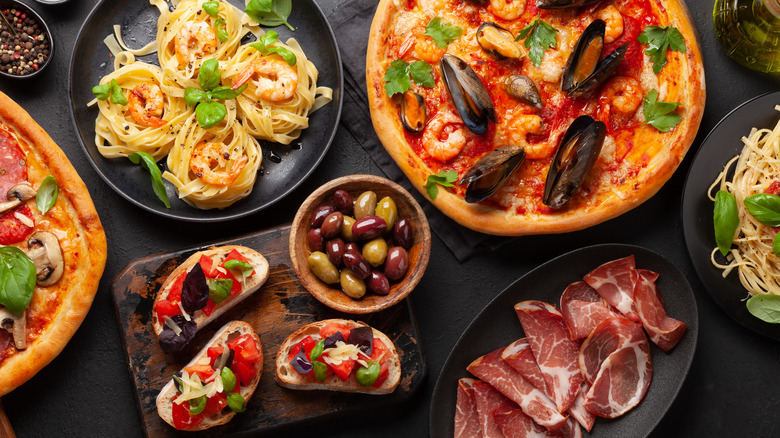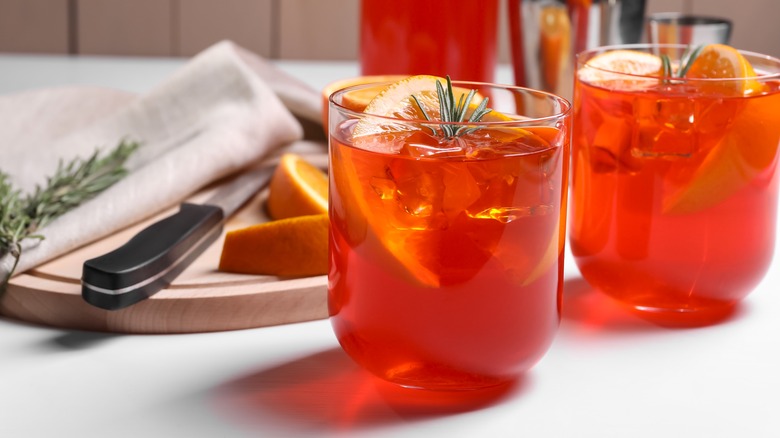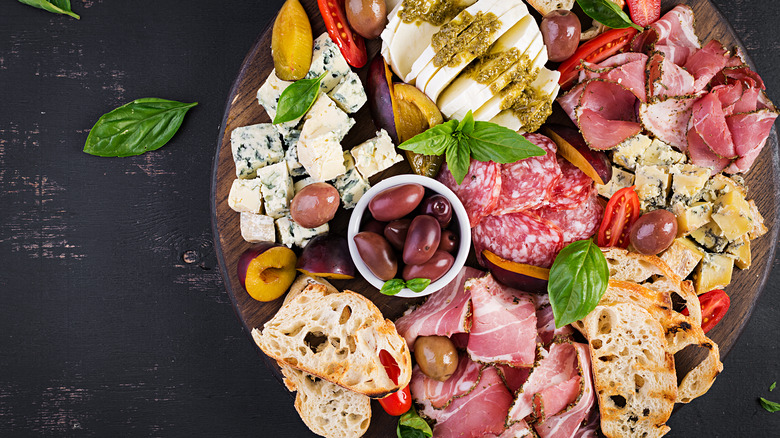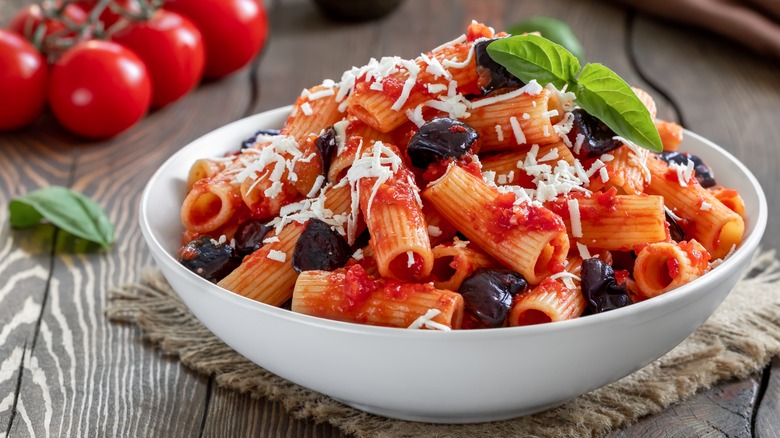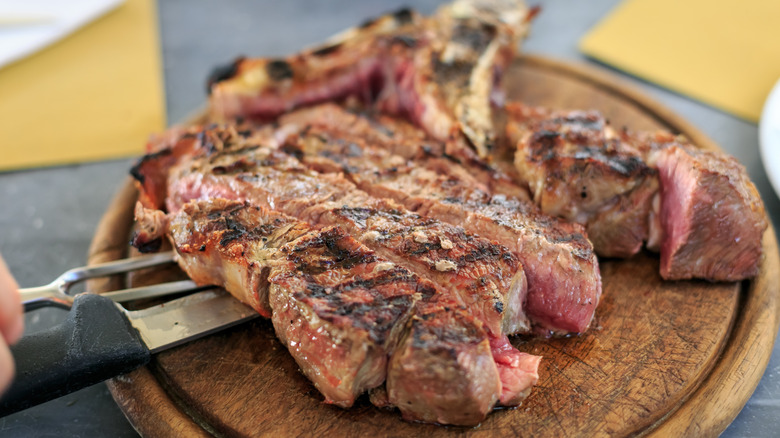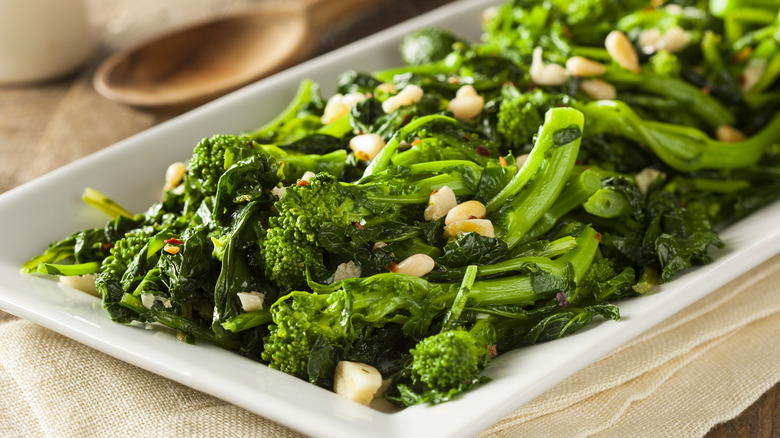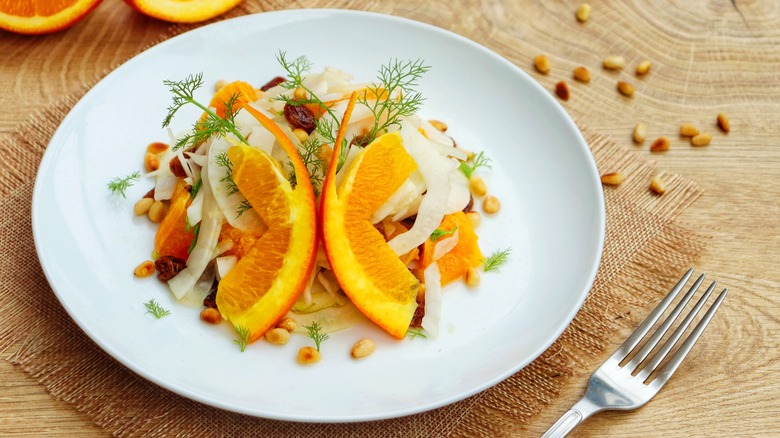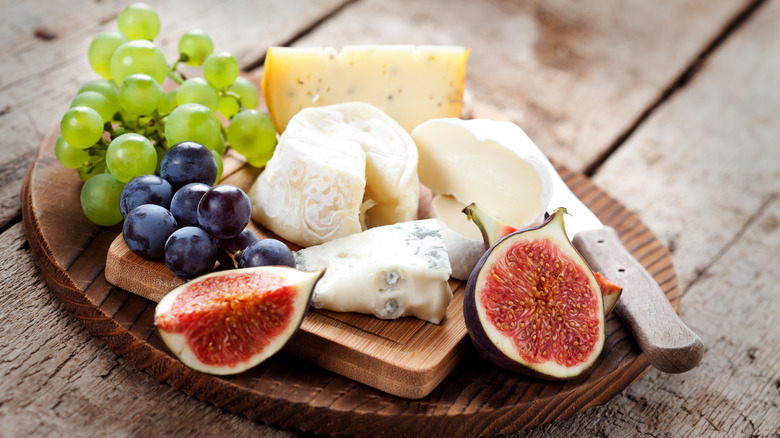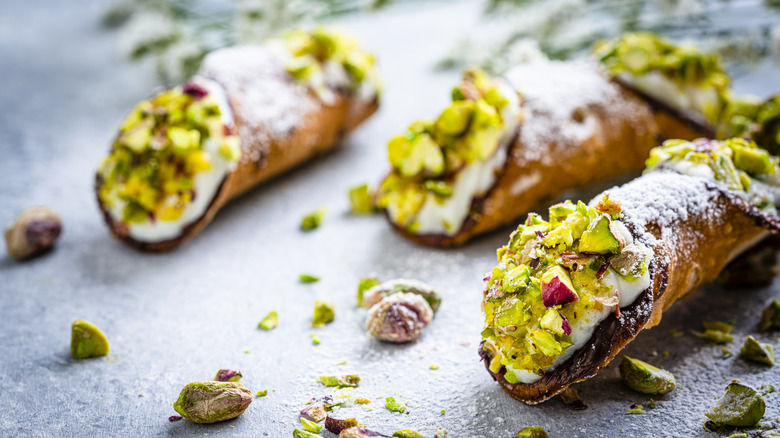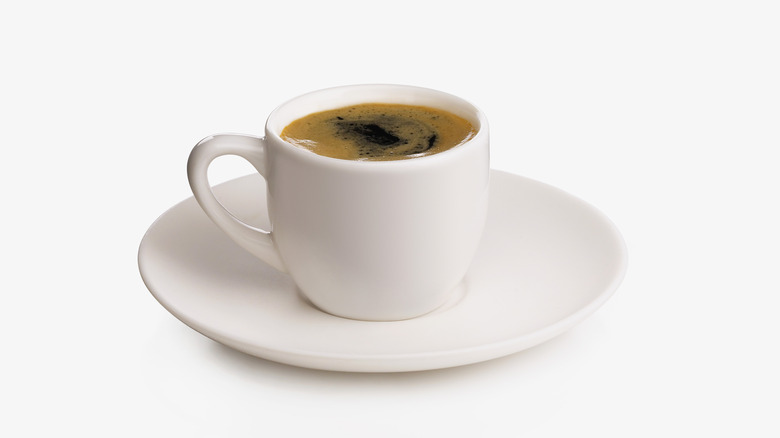A Cheat Sheet Guide To Italian Restaurant Courses, From Antipasti To Dolce
A proper, full course Italian meal can last for hours. It seems like the food just keeps arriving at the table — from the first few plates of antipasti to the sweet desserts. Of course, we don't typically indulge in this kind of lengthy, multi-course feast when we eat at Italian restaurants in America. Italians in Italy are not even sitting down every evening for an enormous meal — if they are, the portions are likely small and manageable. Italian and Italian-American families, on the other hand, embrace the multi-course meal during the holidays.
Obviously, there are no rules when you're eating, but if you find yourself wanting a traditional Italian meal complete with multiple courses, here's a cheat sheet for you. Many Italian restaurants post a traditional order of courses, so it's helpful to know what to expect. You may have found yourself looking at a menu wondering what "contorni" means or what the difference between "antipasto" and "insalata" is. From pre-dinner cocktails to post-dinner digestivi, feel confident in knowing what to expect the next time you sit down at an Italian restaurant — or attend an Italian family celebration. Come with an empty stomach and an open mind and lots and lots of time. After all, these meals are meant to invite you to slow down and be present with family and friends.
Aperitivo
The first part of an Italian meal is the aperitivo. This is basically a pre-meal cocktail that's intended to help you prepare for your meal by stimulating your appetite. But an aperitivo is not just any cocktail — this drink is usually bitter, sparkly, and low-alcohol. Think about cocktails like an Aperol spritz, which is made with Prosecco, Aperol, and sparkling water.
Historically, the word "aperitivo" comes from the Latin phrase "aperire" which means "to open." This relates to the concept that you need to make space in your stomach before eating your meal. It's believed that the the drink originated from the Northern Italian city of Turin in the 18th century when distiller Antonio Benedetto Carpano created the vermouth. Turin had a cafe culture at the time, and the cafes began to serve alcohol with food. This trend soon spread to the rest of Italy, with local takes on the type of drinks served.
Aperitivo has a social significance similar to happy hour. Think about how when your work day is done, it's nice to make plans to see friends or family for some socializing and winding down. In the U.S., happy hour is usually earlier in the evening, around 5 p.m., while in Italy it's more common to have an aperitivo a bit later. It's also not uncommon to pair your aperitivo with small snacks such as olives or crostini.
Antipasto
For many, antipasto is the best part of a multi-course Italian meal. There are so many options that you can fill up right away if you're not careful! Think about antipasto as an appetizer course. The word translates as "before the meal" and that's exactly what it means — food to pick on before the larger plates.
When you order an antipasto, you can expect to get a variety of cheese, cured meats, and vegetables alongside bread. Typical Italian items served as antipasto can vary depending on the region or type of restaurant you're eating at. For example, Sicilian antipasto might include caponata, a sweet and sour cold relish made with eggplant, onion, tomato, capers, raisins, and celery; other variations on this dish includes cured meats such as mortadella or salami and olives. In Florence, you might get a plate of prosciutto, crostini with liver pâté, fried polenta, and pecorino cheese. At an Italian restaurant in America or a holiday party, antipasto might be a combination of roasted red peppers, mozzarella and other cheeses, many kinds of cured meats, pepperoncini, and bruschetta.
Primo
The primo, or the first course, usually consists of a meal that is not meat-based. This part of the menu is where you're likely to find an easy, weeknight dish such as pasta, risotto, or sometimes beans. That doesn't mean meat can't be an ingredient in the primo course — there are hundreds of ways to make pasta, and the ingredients can range from simple pomodoro to creamy carbonara to clam sauce and beyond.
Each region in Italy has a pasta that is noted or special to the area, using local ingredients or respecting traditional preparation. Some believe that spaghetti a la puttanesca might have originated in Naples. Spaghetti with seafood is popular in the Southern regions as well. Tagliatelle a la Bolognese is known for originating in Bologna. This dish features sauce made from a mixture of ground meats such as beef and pork with carrots, onions, and tomato sauce. And carbonara, with its mixture of egg, Parmigiano cheese, and pancetta, is famous in Rome.
Secondo
After the primo course comes the secondo. This course may include fish or meats such as pork, chicken, lamb, and sausage. For vegetarians or vegans, this course will be plant-based — often stuffed vegetables, savory pies, or dishes such as eggplant Parmigiano.
As with all the foods we've been talking about, the secondo course is also connected to food available and popular in the region and the restaurant you're eating at. Many Italian restaurants in America combine regional favorites, but some prefer to focus entirely on the cuisine of one region. For example, a dish synonymous with Florence is bistecca alla fiorentina. This is a beef dish from the cut of the sirloin of a particular breed of cow, the Chianina breed. It's basically a huge T-bone, and served very, very rare. Osso Buco, which was popularized in the Milan area, are braised veal shanks featuring bone marrow still in the bone. Finally, grilled octopus is a favorite from areas near the coast such as Naples.
Contorno
The contorno, which is usually served alongside the secondo, is a vegetable side dish. Since the contorno is served on its own plate, you can order as many as you want depending on how many people are eating. These vegetables can be roasted, grilled, basked, or fried. There are endless options for contorni — and the thing about contorni is that they don't have to be prepared in a complicated way. The best side dishes just need to be made with quality ingredients like good olive oil and fresh herbs and spices.
Some of a few examples of Italian contorni are broccoli rabe sauteed with garlic and chili peppers, roasted fennel, fried potatoes, sliced and grilled artichokes, escarole and white beans, and fried zucchini flowers. There are so many ways to personalize these foods at home, but at a restaurant, expect simplicity as they're designed to complement your primo, not overwhelm it.
Insalata
When do Italians have their insalata, or salad course? It used to be after the main meal, to aid in digestion. In more traditional settings, this can still occur. At Italian restaurants, it can be consumed before, after, or alongside your main course. Italian insalata can be as simple as lettuce greens (peppery arugula and slightly bitter chicory radicchio are popular as well) with oil and vinagrette or more complex to demonstrate the flavors and ingredients native to a region.
Panzanella is a popular dish throughout Italy. It's an Italian salad made from stale bread along with tomato, onion, and basil and dressed in vinegar and olive oil. In Sicily, insalata with fennel and oranges is notable. There are lots of variations with this salad, but you usually add olives, olive oil, mint, and toasted nuts. Shaved artichoke salad is another winner when combined with pecorino and a lemony dressing. The insalata should be a kind of palate cleanser or refreshment dish to be consumed whenever you feel like it!
Formaggi e frutta
Just when you think you can't eat any more, the formaggi e frutta plate arrives — or the delightful cheese and fruit course. The cheeses should be whatever is typical of the region, and the fruits should be seasonal and complementary. It's a chance for the chef or your hosts to show off local cheeses that they're proud of. Italian cheeses are also made locally, with certain cheeses hailing from specific regions.
A few of the most popular and well-known Italian cheeses are Parmigiano Reggiano from the Emilia Romagna region, Pecorino (sheep's cheese — and it's basically made all over Italy), Caciocavallo from Sicily, Taleggio from Lombardy, Asiago, Grana Padano, ricotta salata, and gorgonzola. The fruits are likely fresh and regionally available. Pears and cheese pairs well together; other options include grapes, figs, apples, but berries and stone fruits can also go nicely depending on the kind of cheeses featured.
Dolce
You're not done yet. How can you skip dessert? The dolce course is a chance to have something sweet at the end of your meal. It doesn't have to be a massive slice of layer cake slathered in frosting — it should be a simple but delicious treat to round out the flavors of the rest of the meal. Italian desserts are very different depending on the region, so it might not be feasible to expect a cannoli at a Tuscan restaurant. But literally any Italian dessert you have will be delicious and the perfect ending taste to your meal.
Popular desserts you might find on a menu include tiramisu, panna cotta (sweetened cream fitted into a mold), zeppole, an affogato (ice cream drenched in espresso), fresh fruit tarts, cassata (a sponge cake moistened with liqueur such as Rosolio, layered with ricotta cheese, and housed inside a marzipan shell), zabaglione (made with egg yolks, Marsala wine, and sugar) gelato or sorbet, and crunchy biscuits dappled with almonds or pine nuts.
Caffe
On an Italian menu, caffe traditionally means espresso. You'd get a small cup of strong espresso and pretty much drink it quickly.
For Americans, Italian coffee culture can sometimes be confusing. We both love coffee but in different ways. Americans linger at cafes over multiple cups of coffee or walk around with iced lattes. Italians, on the other hand, stop by a bar to grab a quick shot, and they might do this a few times over the course of their day. In America, there are seemingly endless ways to make coffee taste different than an espresso — add a pump of this sweetener, throw in caramel, plop some whipped cream on top, make art in the shape of a flower in the foam. Italians prefer a heavily roasted, bitter taste. We all have our preferences regarding how we consume coffee and what we like to add to it — or not add to it.
Digestivo
The digestivo is the drink that officially announces your meal is done. And it's supposed to do what it says — help you digest. A digestivo is a liquor with a high alcohol content that has a very strong flavor. It's served straight in a small glass, and you're supposed to sip it. There are many different kind of digestivi. Some of the most well-known include grappa, amaro, limoncello, and sambuca.
Back in the day, grappa, an Italian brandy, had a reputation for making you cry, but as distillation practices have improved over time, grappa can be quite pleasant and have different flavor profiles depending on the brand. Amaro is made from herbs and aromatics and can have a bitter taste — many drinks are now made by mixing amaro with sparkling wine or prosecco (think of that Aperol you had as an aperitif). Limoncello is tart and fruity, made by infusing alcohol with lemon peels and adding vodka and sugar. Sambuca has a strong licorice flavor because it is made with anise. Some even put sambuca in their espresso for a caffè corretto.
